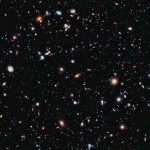main content begins
Hubble also showed that these “island universes” were receding from us, and that more distant ones receded at greater speeds than those closer to us. With this discovery came the understanding that we live in an expanding universe that began billions of years ago in the Big Bang.
Today, when we look out into space, we see that galaxies vary in size, form and nature. Some contain hundreds of thousands of stars; others, hundreds of billions. There are irregulars, ellipticals and spirals. They are made up of stars, gas and dust—but in widely varying proportions. Some radiate thousands of times more energy than others.
Galaxies exist isolated in space, or grouped in clusters; and clusters form super-clusters which, in turn, form a web- or bubble-like structure filling the entire cosmos.
Today, astronomers study these objects to answer the question: how did this universe of galaxies come to be? How and when did the first stars and galaxies form? How do these vast systems evolve? How are the different types related? What role does dark matter play in their formation and evolution?
According to simulations of the early Universe, fluctuations in the density of dark matter evolved into clumps and filaments of dark and baryonic—or “normal”—matter. These concentrations harbored the earliest star formation and formed the seeds of galaxies. Structure then formed from the “bottom-up”: pre-cursors of galaxies merged to form galaxies, which in turn gathered into clusters of galaxies, which formed into super-clusters. Today, the best computer simulations combine baryonic, cold dark matter and dark energy, and result in a universe much like the one we see today.
In addition to their overall formation and evolution, astronomers study the varied nature of galaxies. For example, it appears that all of these star systems of a certain size harbor supermassive black holes (SMB) in their centres, with masses equivalent to millions of Suns. But astronomers have yet to identify the mechanism by which such enormous black holes form. It is also unclear why there is a correlation between the mass of the SMB and the velocity dispersion of the galaxy in which it resides. Regardless, the extreme conditions in galactic nuclei make them excellent laboratories for testing Einstein’s Theory of General Relativity.
In a universe of galaxies, there are many questions about galaxies. What is the role of stellar feedback—energy from star formation and supernovae—on their evolution? Why are there fewer dwarf galaxies than models predict? How does the evolution of an isolated galaxy differ from that of a galaxy in a cluster? By answering these questions, astronomers are gaining an understanding of the lives of galaxies and the history of the Universe.

Hubble eXtreme Deep Field image showing some 5500 galaxies in an area of the sky a fraction of the size of the full moon. Credit: Credit: NASA, ESA, G. Illingworth, D. Magee, and P. Oesch (UC, Santa Cruz), R. Bouwens (Leiden University), and the HUDF09 Team